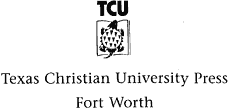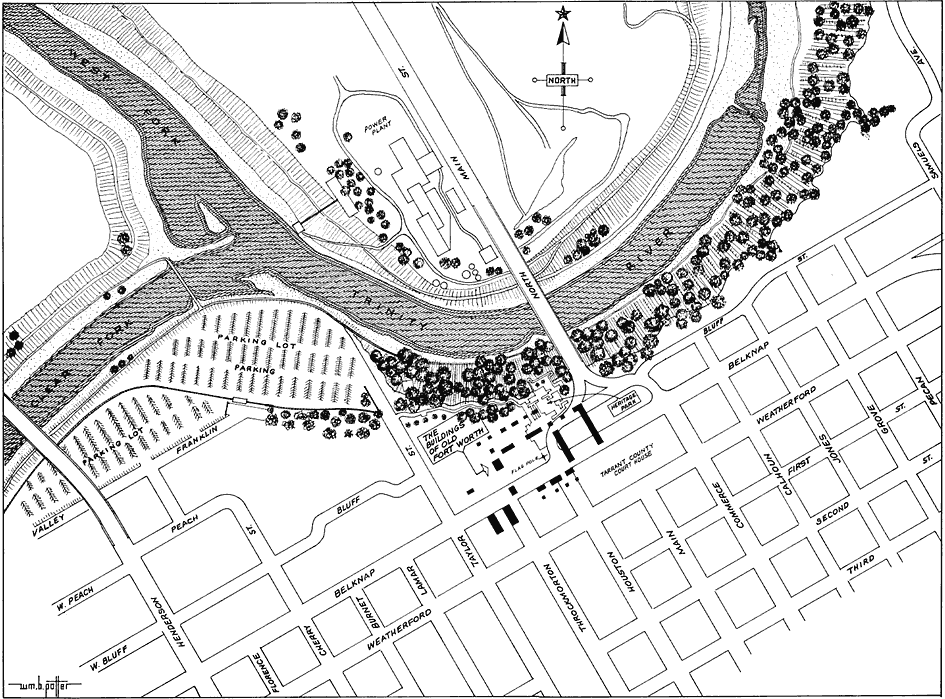Cover

| title | : | The Fort That Became a City : An Illustrated Reconstruction of Fort Worth, Texas, 1849-1853 |
| author | : | Selcer, Richard F.; Potter, William B. |
| publisher | : | Texas Christian University Press |
| isbn10 | asin | : | 0875651461 |
| print isbn13 | : | 9780875651460 |
| ebook isbn13 | : | 9780585381787 |
| language | : | English |
| subject | Fort Worth (Tex.)--History, Fort Worth (Tex.) in art. |
| publication date | : | 1995 |
| lcc | : | F394.F7S46 1995eb |
| ddc | : | 976.4/5315 |
| subject | : | Fort Worth (Tex.)--History, Fort Worth (Tex.) in art. |
Page i
THE FORT THAT BECAME A CITY
Page iii
THE FORT THAT BECAME A CITY
An Illustrated Reconstruction of Fort Worth, Texas, 18491853
Drawings by William B. Potter
Text by Richard F. Selcer

Page iv
Drawings copyright William B. Potter, 1995
Text copyright Texas Christian University Press, 1995
Library of Congress Cataloging-in-Publication Data
Selcer, Richard F.
The Fort that became a city: an illustrated reconstruction of Fort Worth, Texas 18491853 / drawings by William B. Potter: text by Richard F. Selcer.
p. cm.
ISBN 0875651461 (pbk. alk. paper)
1. Fort Worth (Tex.) History. 2. Fort Worth (Tex.) in art
I. Potter, William B. II. Title.
976.45315dc20
957572
CIP
Cover illustration By Dawn's Early Light by William B. Potter
Page v
To my loving wife Betty Smith Potter who kept me supplied with coffee, accompanied me on countless visits to fort ruins and reconstructions, and acted as a constant sounding board throughout this project.
To our sons, William Bradley (Brad) and Barry Smith (Buck) Potter for their helpful support, assistance and encouragement.
To my late father and mother, Frank B. and Birdie Blow Potter, who taught me to love history, my city, my state and my country.
Bill Potter
To Debbie, Ashley and Brett. This one's for you! With love always.
Rick Selcer
Page vi

Page vii
CONTENTS
Bugle calls the origin of the chapter titles in this volume were the way the cavalry communicated in camp and field. Reveille and Fatigue, for example, were service commands for men to rise in the morning and for troopers to report for work details. More than two dozen calls divided the day into convenient segments. For a detailed account, see Randy Steffen, The Horse Soldier, 17761943, Volume 1, The Revolution, the War of 1812, the Early Frontier, 17761850 (Norman: University of Oklahoma Press, 1977).
On the facing page: the original site of Fort Worth is superimposed on the present-day courthouse area.
| 1Boots and Saddles | 1 |
| 2To Arms | 7 |
| 3Reveille and Fatigue | 25 |
| 4Call to Quarters | 35 |
| 5Fort Worth: An Artist's Reconstruction | 47 |
| 6Officers' Call | 69 |
| 7Guard Mounting | 85 |
| 8Adjutants Call | 101 |
| 9Form Ranks | 111 |
| 10Assembly | 119 |
| 11To Horse | 125 |
| 12Tattoo | 137 |
| 13Taps | 147 |
| Appendix | 155 |
| Notes | 156 |
| Bibliography | 186 |
| Index | 193 |
Page ix
ACKNOWLEDGEMENTS
Two projects led to the publication of this book, neither of which has become a reality at this date. First: a full scale replica of the original Fort Worth. Second: a Fort Worth cyclorama and historical museum. Many persons were supportive of these and deserve my sincere appreciation. As for the book, The Fort That Became a City, I would like to express my gratitude to the following individuals who offered their support, information, and encouragement during it's creation. Judy Alter and Tracy Row of TCU Press, Ed and Ruby Briscoe, Betty Regester, Frank Perkins, Bill Wardlaw-Brown, Bill Norris, and Rick Selcer, whose comprehensive text and tireless effort combine to give this book the final touch.
William B. Potter
No historian can hope to write a properly researched book without the contributions of many anonymous helpers. This book represents the combined efforts of lots of people in the last two years, only a few of whom I can mention by name here. Thanks to Bill Potter who first had the idea for a volume on Fort Worth and followed his dream; to Betty Regester, former curator at Log Cabin Village in Fort Worth, for turning over a wealth of research collected over years of diligent work; to Ruby Schmidt for proofing an early draft of the manuscript and for sharing her expertise on many occasions; to Dee Barker for opening up the Tarrant County Historical Commission to me on holidays and off-times and pitching in with the research; to Ken Hopkins for digging out the obscure and the forgotten from the Fort Worth Public Library files; to the underpaid and overworked staff of the Military Reference Branch of the National Archives, Washington, D.C., for helping me make sense of arcane U.S. Army records; to Cornelia Pym at the Fort Worth Public Library for double-checking countless footnote references; to John Shiflet for being my tour guide through Pioneer's Rest Cemetery; to my editor Tracy Row for his unflagging patience during countless rewrites. And a special note of gratitude to Lois Biege for typing footnotes late into the night and for too many little research errands to enumerate. To anyone else I left out, I apologize and I salute your contributions.
Richard F. Selcer
Page 1
1
BOOTS AND SADDLES
A small party of mounted dragoons and scouts rode in a rough line of march through thick woods, following a course roughly parallel to the Trinity River, several hundred yards to their right. A faint trail provided a narrow path through the dense undergrowth of trees, bushes and vines all around them. With their view to the river blocked by the tangled thicket, each man studied the back of the man in front of him or cast nervous glances at the undergrowth around them. The creaking of saddle leather and jangle of harness gear barely disturbed the still air as they proceeded in columns of two. A string of pack horses was strategically placed in the middle of the column where the men could guard it against possible attack. Food, supplies, tools, and extra ammunition were on those horses. The men's wariness was born of experience, not the presence of visible Indian signs. As far as they could tell, they were the only people in the world or at least in this part of Texas.
Next page







